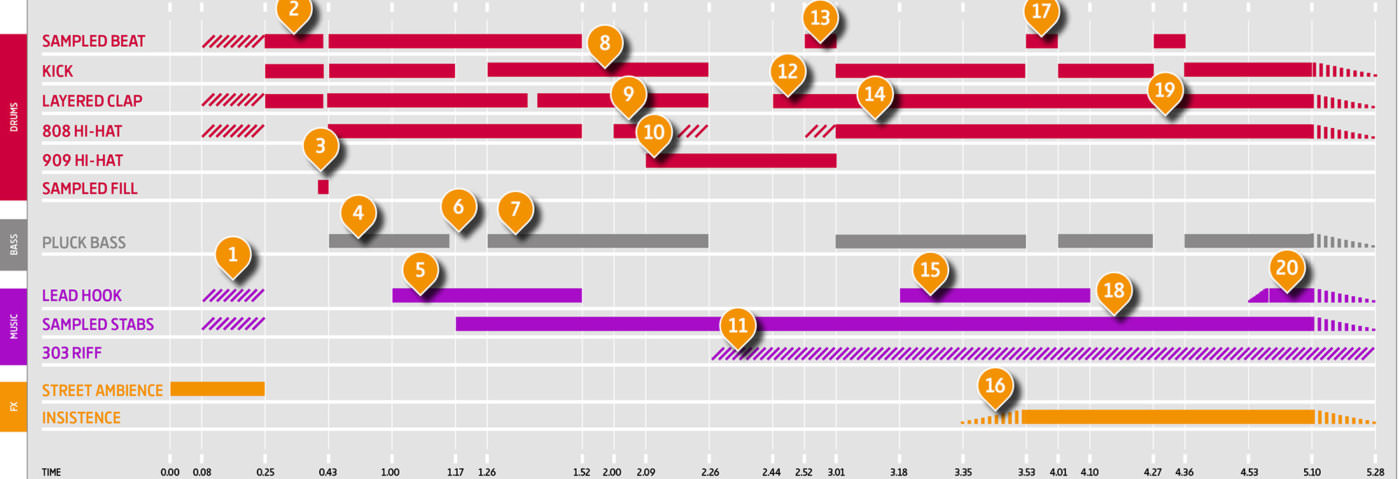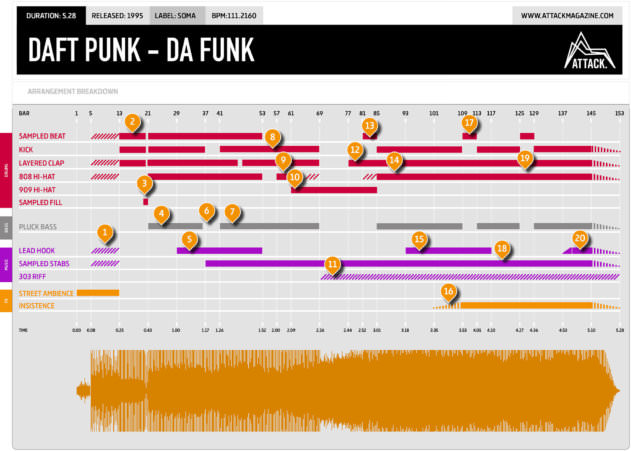By popular demand, we deconstruct the arrangements of tracks to see what we can learn from their structure.
Having covered two more recent tracks in our first deconstructions, we turn our attentions to a classic. Daft Punk’s ‘Da Funk’ is a masterpiece in melodic and structural simplicity, with a few clever tricks to boot.
The track
The arrangement
What’s happening?
1. Eight seconds of crowd ambience leads into the first iteration of both the distorted lead hook and sampled stabs – alongside a complete mix of the layered drum parts. It’s an unusual kind of exposition: within the first 10 seconds of the song, almost all major track elements are playing. The caveat is that these parts are all re-sampled – with both the extreme high and low ends of the frequency spectrum filtered away.
within the first 10 seconds of the song, almost all major track elements are playing
2. The musical elements drop out to make way for the beat, which enters doubly hard after the low-cut resample of the previous section. The beat comprises a noisy sampled loop, replete with original reverb (taken from Vaughan Mason and Crew’s ‘Bounce, Rock, Skate, Roll’) layered with a deep, club-friendly kick and a layered 909/white noise clap. As in many Daft Punk productions, the stereo field is kept deliberately narrow. The main exception is the clap, which apparently randomly scatters around the speakers.
3. At bar 20, all beat elements are silenced as a sampled drum break (from Barry White’s ‘I’m Gonna Love You Just A Little More Baby’) takes centre stage. This is the first and only time it will play.
4. The beat returns, this time underpinned by the plucked synth bass – an absurdly simple on-the-beat G that in different producers’ hands might have sound offensively dull. As it is, its role is to anchor the energy only, underpinning the groove and allowing other parts to take the melodic and rhythmic leads. Note the addition of a fourth layer of drums over the sampled beat: this time a carefully sculpted 808 hi-hat.
5. In comes the lead riff, weaving effortlessly into the wide area of mix estate available in the middle frequencies. What powers the riff? Roland SH-101, Juno-106, Yamaha CS-15, MiniKorg 700s? Who knows…
6. ‘Da Funk’ is mostly governed by 8-bar turnarounds, but there are exceptions. Here’s the first: a four-bar section in which the bass and layered kick drops out and the sampled stab is reintroduced. Breaking up the length of the loops like this maintains interest, toying with the expectations of the listener and dancefloor. Note that the bass ends a bar before the turnaround – it’s a simple trick to signal the coming change and help ease the transition.
7. The bass returns. An easily missable detail is the brief muting of the layered clap in bar 44.
8. The lead hook ends as the track strips back to basics. The rhythm section now comprises kick and clap only. The sampled beat has gone, only to appear subsequently during short breaks.
9. The 808 hi-hat re-enters. Listen carefully and you’ll hear the same random panning on this part as the 909 clap, only subtler – a nice way of bringing unity to disparate parts.
10. Only Daft Punk could enlist a closed 909 hi-hat to perform solo duties. And here it is: the hi-hat taking brazen centre stage, sculpting a new groove against the driving bass and stabs. At bar 65 an occasional 808 hat, panned right and mixed low, adds a simple response to the 909’s call.
11. The 909 hi-hat continues to carry the groove alongside the stabs as one of the most iconic TB-303 sequences in dance music enters the mix. It’s an ever-changing acid line, with the cutoff frequency and resonance always on the move. It starts out with cutoff dialled low.
The 909 hi-hat continues to carry the groove alongside the stabs as one of the most iconic TB-303 sequences in dance music enters the mix
12. As the filter opens, the clap returns. Exposed in the mix, you get a chance to listen to how it’s made: one layer is a 909 clap and the other is what sounds like a white noise hit or a randomly-panned slapback reverb return fed by the clap.
13. The sampled beat makes a brief reappearance, along with the same subtle 808 hi-hat groove debuted in bar 65.
14. As the bass returns, the 909 hi-hat leaves the mix and the rhythm returns to its stock groove: kick, clap and 808 hat. The lead 303’s cutoff frequency is still on the move, ensuring the listener’s attention never wanders.
15. The opening hook returns so that all three music parts are in the mix. The complete mix is extended for a full 16 bar section.
16. An as-yet-unheard element fades in for eight bars: a 16th-note stabby synth sound that plays in the upper registers, is heavily effected and, like the bassline, sticks to just one note. We’ve called it ‘insistence’.
17. Break! The kick and bass are muted as the insistence pads out the mix, spilling into the gaps between the other elements. Its effect is to up the energy of the track a notch further.
18. The lead hook is cut, leaving the 303 to jostle with the stabs and the insistence, scattering its delays around a strictly defined panning range.
19. The kick and bass are muted as in bar 109 – a final arrangement flourish as the track heads for the finish line. Heavy bus compression allows the insistence to take up the slack.
20. The lead hook fades in for one last triumphant taste of the limelight before the whole mix is faded out.


10.09 AM
This track is a old favorite of my and now I can see how it is deconstructed. It even inspires me making a new track. Love this post 🙂
11.10 AM
That would be great to compare it with an EDM hit, containing tons of little glitches and fx, micro 2 bars loops and so on… Because, imo, it is not as simple as it sounds…
03.43 AM
can we Deconstruct that music video?
CHARLES!?!